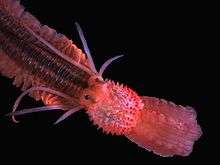Phyllodocidae
Phyllodocidae is a family of polychaete worms. Worms in this family live on the seabed and may burrow under the sediment.
| Phyllodocidae | |
|---|---|
 | |
| Phyllodoce lineata with everted pharynx | |
| Scientific classification | |
| Kingdom: | |
| Phylum: | |
| Class: | |
| Order: | |
| Family: | Phyllodocidae |
| Genera | |
|
| |
Characteristics
Members of the Phyllodocidae are characterised by an eversible pharynx and leaf-like dorsal cirri. The head has a pair of antennae at the front, a pair of ventral palps and a single median antenna known as a "nuchal papilla". There is a pair of nuchal organs and there may or may not be a pair of eyes. The first two or three body segments may be part-fused and bear up to four pairs of tentacular cirri. The remaining body segments each bear leaf-like dorsal and ventral cirri, the dorsal ones being larger. The parapodia are uniramous or biramous, and chaetae are present on all but the first segment.[2]
Genera
The World Register of Marine Species includes the following genera :[1]
- Subfamily Eteoninae Bergström, 1914
- Genus Eteone Savigny, 1818
- Genus Eulalia Savigny, 1822
- Genus Eumida Malmgren, 1865
- Genus Galapagomystides Blake, 1985
- Genus Hesionura Hartmann-Schröder, 1958
- Genus Hypereteone Bergström, 1914
- Genus Mystides Théel, 1879
- Genus Protomystides Czerniavsky, 1882
- Genus Pseudomystides Bergström, 1914
- Genus Pterocirrus Claparède, 1868
- Genus Sige Malmgren, 1865
- Subfamily Notophyllinae Pleijel, 1991
- Genus Austrophyllum Bergström, 1914
- Genus Clavadoce Hartman, 1936
- Genus Nereiphylla Blainville, 1828
- Genus Notophyllum Örsted, 1843
- Subfamily Phyllodocinae Örsted, 1843
- Genus Chaetoparia Malmgren, 1867
- Genus Levisettius Thompson, 1979 †
- Genus Paranaitis Southern, 1914
- Genus Phyllodoce Lamarck, 1818
References
- Fauchald, Kristian (2008). Read G, Fauchald K (eds.). "Phyllodocidae Örsted, 1843". World Polychaeta database. World Register of Marine Species. Retrieved 22 July 2017.
- Australian Biological Resources Study (2000). Polychaetes & Allies: The Southern Synthesis. Csiro Publishing. p. 145. ISBN 978-0-643-06571-0.